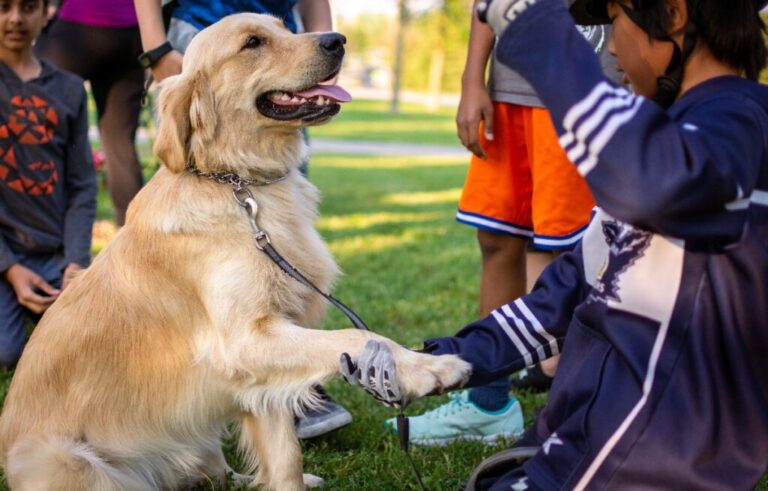Is the Labrador Retriever the Perfect Family Pet? Unveiling the Truth
Labrador Retrievers: A Perfect Match for Families?
When it comes to finding a family pet, Labrador Retrievers are often considered a perfect match. Their versatility and friendly temperament make them an ideal choice for families with children. Let’s explore why Labrador Retrievers are so well-suited for families.
The Versatile Labrador Retriever
Labrador Retrievers are known for their versatility and adaptability. They are a breed that enjoys a variety of activities, making them well-suited for active families. Whether it’s playing fetch in the backyard, going for long walks, or participating in agility or obedience training, Labrador Retrievers are up for the challenge. Their energy and enthusiasm make them great companions for families who lead an active lifestyle. According to the American Kennel Club, Labrador Retrievers excel in activities like agility, dock diving, and competitive obedience.
Friendly and Outgoing Temperament
One of the standout qualities of Labrador Retrievers is their friendly and outgoing temperament. They are known for their good-natured and gentle disposition, which makes them excellent family dogs. Labrador Retrievers have a natural affinity for children and are often patient and tolerant, making them great companions for kids of all ages. Their friendly nature extends to other animals as well, making them a suitable choice for families with other pets. According to the American Kennel Club, Labrador Retrievers are known for their friendly and outgoing personalities.
Labrador Retrievers also have a reputation for being intelligent, trainable, and eager to please. This combination of traits makes them highly adaptable to different living situations and allows them to integrate well into family life. They are quick learners and respond well to positive reinforcement training methods.
Before bringing a Labrador Retriever into your family, it’s important to consider factors such as exercise and activity requirements, the need for companionship and mental stimulation, and the long-term commitment involved. Labrador Retrievers thrive when they receive regular exercise, mental stimulation, and plenty of love and attention from their family members. Ensuring that their needs are met will help them become well-rounded, happy, and well-behaved companions.
Labrador Retrievers are not only beloved family pets but also highly regarded working dogs, excelling in roles such as service dogs, therapy dogs, and search and rescue dogs. Their versatility, intelligence, and friendly nature make them a perfect match for families looking for a loyal and loving companion.
In the next sections, we will further explore the reasons why Labrador Retrievers are popular, their physical characteristics and care requirements, as well as their training needs, helping you make an informed decision about whether a Labrador Retriever is the right addition to your family.
Why Labrador Retrievers are Popular
Labrador Retrievers have earned their status as the most popular dog breed in America for several reasons. Their intelligence, trainability, and willingness to please make them an excellent choice for families looking for a loyal and well-rounded companion (AKC). Let’s explore why Labrador Retrievers are so highly regarded and beloved by many.
Intelligence, Trainability, and Willingness to Please
Labrador Retrievers are known for their sharp intellect and quick learning abilities. Their intelligence allows them to understand and respond effectively to training, making them highly trainable dogs. They respond well to positive reinforcement training methods, such as rewards and praise, and are eager to please their owners (Moms Who Think).
The combination of their intelligence and willingness to please makes Labrador Retrievers excellent candidates for obedience training. This training process not only helps establish a strong bond between the dog and their family but also provides a great opportunity for family members, including children, to participate in training activities together. It can be a rewarding and fun experience that strengthens the family unit.
Most Popular Dog Breed in America
Labrador Retrievers have consistently held the top spot as the most popular dog breed in America for many years. Their friendly and outgoing temperament, versatility, and suitability for families have contributed to their enduring popularity (AKC). People are drawn to their loving nature, patience, and even-tempered disposition, which makes them great companions for individuals and families alike.
Labrador Retrievers come in three main color variations: yellow, black, and chocolate. Their appealing physical characteristics, combined with their amiable nature, make them sought-after pets for families looking to add a new member to their household. The Lab’s versatility as a family pet, working dog, and therapy dog further contributes to their widespread popularity.
Labrador Retrievers have rightfully earned their reputation as wonderful family pets due to their intelligence, trainability, and willingness to please. Their popularity in America and their ability to adapt to various lifestyles and living situations make them a top choice for many prospective dog owners. If you’re considering adding a Labrador Retriever to your family, be prepared to provide them with consistent training, mental stimulation, and the love and care they deserve.
Physical Characteristics and Care
Labrador Retrievers are known for their sturdy build and distinctive physical characteristics. Understanding their physical traits and care requirements is essential for prospective Labrador owners.
Sturdy and Solid Build
Labrador Retrievers have a medium to large-sized body with a sturdy and solid build. They possess an athletic and agile physique, making them excellent swimmers and retrievers. Their strong bodies enable them to participate in various physical activities, including sports and outdoor adventures. Labrador Retrievers are well-suited for active families who enjoy engaging in exercise and play with their furry companions (Source).
Coat and Grooming Needs
Labradors have a double coat that provides insulation and protection from various weather conditions. While their coat is designed to keep them comfortable, it does require regular grooming to manage shedding. Labrador Retrievers shed seasonally, and during these periods, more frequent brushing is necessary to control loose hair. Regular grooming also helps to maintain the health and cleanliness of their coat. It’s important to note that Labradors are known to be heavy shedders, so families considering this breed should be prepared for ongoing grooming efforts. For more information on how to groom your Labrador Retriever, check out our article on how to groom your Labrador Retriever (AKC).
Common Health Issues
Like any breed, Labrador Retrievers may be prone to certain health issues. While they are generally considered a healthy breed, it’s important for prospective owners to be aware of potential health concerns. Common health issues in Labrador Retrievers include hip and elbow dysplasia, progressive retinal atrophy, and exercise-induced collapse. Regular veterinary check-ups and preventive care, such as vaccinations and proper nutrition, are crucial for maintaining the overall health and well-being of Labradors. To learn more about Labrador Retriever health issues and care, refer to our comprehensive guide on Labrador Retriever health issues and care (AKC).
By understanding the physical characteristics and care requirements of Labrador Retrievers, you can provide the necessary care and attention to keep your furry friend happy and healthy. Regular grooming, exercise, and veterinary care are key components of responsible Labrador ownership.
Labrador Retrievers and Families
Labrador Retrievers are often considered a perfect match for families due to their great companionship, adaptability, and the need for training and mental stimulation.
Great Companions for Children
Labrador Retrievers are known for their friendly and outgoing temperament, making them excellent companions for children (The Labrador Site). Their kind and patient nature allows them to interact well with kids, and they are often gentle and tolerant of their playful antics. Labs are known to form strong bonds with children and can be a source of comfort and companionship.
When introducing a Labrador Retriever to children, it’s important to teach both the children and the dog how to interact safely and respectfully. Supervision is crucial, especially with younger children, to prevent any accidental harm or mishaps. Socializing your Labrador Retriever from a young age and exposing them to different experiences can help ensure they grow up to be well-rounded and well-behaved around children (socializing your labrador retriever).
Adaptable to Different Living Situations
Labrador Retrievers are highly adaptable dogs that can fit into various living situations. Whether you live in a house with a backyard or an apartment, Labs can adjust to their environment with ease. They are a versatile breed and enjoy a variety of activities, such as agility, dock diving, and competitive obedience. However, it’s important to note that Labs are energetic dogs, and regular exercise is essential to keep them physically and mentally stimulated. For more information on exercise needs, check out our article on exercise needs of Labrador Retrievers.
Labrador Retrievers are also known for being adaptable to different family dynamics. Whether you have a small family, a large family, or live alone, Labs have the ability to form strong bonds and provide companionship to everyone in the household. They thrive on human interaction and love being a part of family activities.
Training and Mental Stimulation
Training is an important aspect of owning a Labrador Retriever. Labs are highly trainable and eager to please their owners, which makes them excellent candidates for obedience training and other activities. Consistent and positive reinforcement training methods work best with Labs, as they respond well to rewards and praise. Training not only helps in teaching basic commands and manners but also provides mental stimulation and helps prevent behavioral issues.
Mental stimulation is crucial for Labrador Retrievers to keep them engaged and prevent boredom. Labs are intelligent dogs and enjoy tasks that challenge their minds. Incorporating puzzle toys, interactive games, and training sessions into their daily routine can help keep their minds sharp and prevent destructive behaviors that may arise from boredom.
By considering the compatibility of Labrador Retrievers with children, their adaptability to different living situations, and the need for training and mental stimulation, you can determine if they are the right fit for your family. Remember, owning a Labrador Retriever requires time, commitment, and responsible ownership to ensure they thrive and become cherished members of your family.
Considerations for Prospective Owners
If you’re considering adding a Labrador Retriever to your family, there are important factors you should take into account. Labrador Retrievers are wonderful companions, but it’s essential to understand their specific needs and requirements to ensure a harmonious and fulfilling relationship. Here are three key considerations for prospective Labrador owners:
Exercise and Activity Requirements
Labradors are known for their high energy levels and require a significant amount of exercise to keep them happy and healthy. Regular physical activity is essential for preventing boredom and promoting overall well-being. Labs love to play fetch, swim, and engage in other interactive games. Aim for at least an hour of exercise each day, such as brisk walks, jogging, or playing in a spacious, secure area. For more information on the exercise needs of Labradors, you can refer to our article on exercise needs of Labrador Retrievers.
| Activity | Frequency |
|---|---|
| Brisk Walk | 1-2 times daily |
| Playtime/Fetch | Daily |
| Swimming | Weekly |
Need for Companionship and Mental Stimulation
Labradors are highly sociable and thrive on companionship. They form strong bonds with their human family members and can suffer from separation anxiety if left alone for extended periods. Labradors are well-suited to families where someone is typically home during the day or can provide frequent social interaction. Engaging your Labrador in activities and providing mental stimulation is also crucial. Interactive toys, puzzle feeders, and training exercises can keep them mentally stimulated and prevent boredom. For more information on providing mental stimulation for Labradors, refer to our article on choosing the right toys for Labrador Retrievers.
Long-Term Commitment
Bringing a Labrador Retriever into your family is a long-term commitment. Labradors have an average lifespan of 10 to 12 years, and in some cases, even longer. As a Labrador owner, you’ll need to provide ongoing care, including regular veterinary check-ups, vaccinations, and preventive treatments. Additionally, Labradors require grooming, training, and attention to their diet and nutrition for optimal health. It’s important to consider the financial and time commitments associated with owning a Labrador Retriever.
By understanding and addressing these considerations, you can ensure that you’re fully prepared for the responsibilities of owning a Labrador Retriever. With the right amount of exercise, companionship, and long-term commitment, Labradors can be a loving and cherished addition to your family. For more information on Labrador Retriever care, behavior, and other related topics, you can explore our comprehensive collection of articles.
Training Labrador Retrievers
Labrador Retrievers are renowned for being eager to please and highly trainable. Their intelligence and willingness to learn make them an excellent choice for families seeking a trainable and well-behaved companion. Whether you’re starting with a Labrador Retriever puppy or adopting an adult dog, training is an essential part of their development.
Eager to Please and Highly Trainable
Labrador Retrievers are known for their eagerness to please their owners. This inherent desire to make their humans happy makes them highly trainable. They are quick learners and respond well to positive reinforcement techniques. By using rewards such as treats, praise, and playtime, you can motivate and encourage your Labrador Retriever during training sessions.
However, it’s important to note that individual Labs may have different personalities and temperaments. While some may be quick learners, others may be more stubborn and require extra patience during the training process. Understanding your Labrador Retriever’s temperament and tailoring your training strategies accordingly can help you achieve the best results.
Challenges and Tips for Training
Training a Labrador Retriever comes with its own set of challenges. One common challenge is their tendency to be easily distracted, especially during their puppyhood. To overcome this, it’s important to create a structured and consistent training routine. Keep your training sessions short and engaging, focusing on one command or behavior at a time. Gradually increase the difficulty level as your Labrador progresses.
Consistency is key when training Labrador Retrievers. Use clear and concise commands, and reward them promptly when they exhibit the desired behavior. Avoid harsh or punitive training methods, as Labs respond best to positive reinforcement and gentle guidance.
Socialization is another crucial aspect of training for Labrador Retrievers. Exposing them to different environments, people, and animals from a young age helps them develop into well-rounded and confident dogs. Consider enrolling your Labrador Retriever in puppy socialization classes or organizing playdates with other friendly dogs.
Professional Insights and Behavioral Recognition
Seeking professional guidance can be immensely helpful when training your Labrador Retriever. Professional trainers have experience working with Labs and can provide valuable insights and techniques tailored to your dog’s specific needs. They can help you address any behavioral issues, offer personalized training plans, and guide you through the training process.
Advancements in behavioral recognition, such as machine learning algorithms, have also provided new tools for understanding and training Labrador Retrievers. These technologies can assist in identifying behavioral patterns, predicting potential challenges, and developing effective training strategies.
Remember, training is an ongoing process throughout your Labrador Retriever’s life. Consistency, patience, and positive reinforcement are essential for successful training outcomes. By investing time and effort into training your Labrador Retriever, you can cultivate a well-behaved and obedient companion who brings joy and happiness to your family.
Final Thoughts on Labrador Retrievers
Labrador Retrievers, also known as Labs, are beloved for their friendly nature and high intelligence. Their characteristics make them an excellent choice for families seeking a loyal and affectionate companion. Let’s take a closer look at some key points to consider when it comes to Labrador Retrievers and their suitability as family pets.
Friendly Nature and High Intelligence
Labrador Retrievers are renowned for their friendly and outgoing temperament, which makes them a perfect fit for families (Labrador Medical). They are known to be sociable, gentle, and patient, making them great companions for both children and adults. Labs have a natural instinct to please their owners and are highly trainable, thanks to their intelligence. Their desire to please makes them well-suited for various activities, including service work and therapy dog programs.
Consistent Training for Well-Behaved Companions
While Labrador Retrievers are intelligent and eager to please, consistent training is essential to ensure they become well-behaved companions. Some Labs may be quick learners, while others may be more stubborn and require additional patience during the training process. It’s important for prospective owners to understand the breed’s temperament and specific training strategies to effectively train their Labs.
To train a Labrador Retriever successfully, it is advisable to seek expert advice and insights from professional trainers. These professionals can provide valuable guidance on training techniques tailored to Labs, helping owners create a positive and productive training environment.
Consistency is key when training Labrador Retrievers. Establishing clear rules, using positive reinforcement methods, and providing mental stimulation are essential for their overall development. By investing time and effort into training, you can ensure that your Labrador Retriever grows into a well-behaved companion.
To further explore the topic of training Labrador Retrievers, check out our article on training tips for Labrador Retrievers. It provides valuable insights and practical advice to help you navigate the training journey with your Labrador Retriever.
Labrador Retrievers possess a unique combination of friendliness, intelligence, and trainability, making them an excellent choice for families. With consistent training and proper care, Labs can bring joy, companionship, and endless love to your household.






